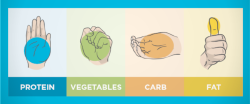How Hand-Size Portions Can Help You to Lose Weight and Eat Healthier

Now, don't get me wrong: calories do "count" (and I love crunching numbers!). If you eat more calories than your body burns, you will gain weight. But I like using hand-sized portions now when it comes to helping my clients lose weight.
It's a great way to visualize portions without getting out the food scale or measuring cups. And you can use it anywhere, anytime -- even out in a restaurant or away on vacation.
And not only do you have your hand at all times for easy reference, the sizeof the portions is proportional to your body. Making hand-sized portions personalized to YOU and your nutritional needs.
What are Hand-Sized Portions?
We break down the portions into four different sizes:- palm,
- closed fist,
- cupped hand
- thumb.
Protein portion = palm of your hand (same thickness and diameter)
Vegetables portion (non-starchy) = closed fist
Carbs portion (starchy vegetables, grains and fruit) = cupped hand
Fats portion = thumb ( from the tip to the 2nd joint)
I also have a worksheet you can download as a reference. (BTW, it’s the same one I use with my clients.)
Download my Hand-Sized Portion Guide right now.
If you need a more visual explanation, here’s a video of me explaining the hand portions. In it, I show you exactly what I mean.
Now that you know what the portions look like, the question is; How many hand-sized portions should you eat a day?
The answer is: it depends on your gender. You can use the following numbers as a starting off point for weight loss. It assumes you are active and eat four meals a day.
Hand-size Portions for Women Per Meal (4 Meals a Day)
- 1 palm of protein (around 3 to 4 oz)
- 1 closed fist of veggies (about 1 cup)
- 1 cupped hand of carbs (starchy carbs, fruit) (about 1/2 cup)
- 1 thumb of fat (about 1 tbsp)
~Approximately 1450 cals per day
Example of 1 day of portions for women
- 4 palms of protein;
- 4 closed fists of veggies;
- 4 cupped hands of carbs (or less*);
- 4 thumbs of fat (or more*).
* Low carb: skip the cupped hand of carb at breakfast and lunch; replace each with a thumb of fat.
Hand-size Portions for Men Per Meal (4 Meals a Day
- 1.5 - 2 palm of protein (around 4 oz per palm)
- 1.5 - 2 closed fists of veggies (about 1 cup per fist)
- 1.5 - 2 cupped hand of carbs (starchy carbs, fruit) (about 2/3 cup per cupped hand)
- 1.5 - 2 thumb of fat (about 1 tbsp)
Example of 1 day of portions for men
- 8 palms of protein;
- 8 closed fists of veggies;
- 8 cupped hands of carbs (or less*);
- 8 thumbs of fat (or more*)
CLICK HERE TO DOWNLOAD THE HAND-SIZE PORTION GUIDE
Carb, Protein and Fat Percentage Breakdown for Hand-Size Portions
If you follow the recommendations up above (4 X each portion per day for women; 6 - 8 of each hand-size portion per day for men), you’ll get an approximate C/P/F breakdown of:Carbs: 35%
Protein: 33%
Fat: 32%
The C/P/F percentages are evenly split, more or less. This can be a simple way to get started without worrying about carb, protein and fat percentages. Especially if you don’t get carb cravings.
But, for some of us, especially those with carb cravings, the carb portion might be a bit too high.
What you can do in that situation is replace two portions of carbs (so, two cupped hands) with two thumbs of fat (or a combination of fat and protein). The best time to do that is at breakfast and lunch.
A higher fat/protein combo at breakfast and lunch will help keep your blood sugar stable and ward off carb cravings.
A word of warning: You don’t want to drop the carbs entirely and not replace it with something. You’ll be eating too few calories, you’ll get hungry -- and hangry! -- and you’ll end up craving carbs.
So, make sure you swap that portion of carbs with a portion of fat (or a combination of fat and protein).
Here’s what the hand-size portions look like if you want to go low carb.
Low Carb Handsize Portions for Women
Total for 1 Day- 5 palms of protein
- 4 closed fists of vegetables
- 2 cupped handfuls of starchy carbs (for later in the day)
- 6 thumbs of fat (added at breakfast and lunch)
Carbs: 23%
Protein: 35%
Fat: 46%
All numbers are approximate. Again, this is just a starting off point.
How to Use Hand-Size Portions to Lose Weight
Now that you have a better understanding of hand-size portions, how can you use it to lose weight? Start practicing at your very next meal! With your plate in front of you, put on your scientist hat and analyze what’s on the plate.A note about “scientist hat”: This is something i do with my clients. What it means is, look at this as an experiment and as a way of gathering information. There should be no emotion attached to it (OMG, that’s a huge portion! Urrgh, this doesn’t look healthy at all!) None of that!
You also don’t have to analyze the whole plate if it’s too much to do at one time.. You can start with analyzing only the protein portion, for example, if that makes it easier.
What Hand-Size Portions Looks Like on a Plate
Protein (1 palm for women; 1.5 to 2 for men)Take a look at the protein on your plate. This could be animal source of protein (chicken, beef, fish) or other sources like tofu, cottage cheese, protein powder, eggs.
Now compare it to the size of your palm. Is the portion on your plate close in size? Is it too little? Too much? Make either a mental note of it -- or better yet, print out the sheet and write it down on the sheet.
Vegetables (1 closed fist for women; 1.5 to 2 for men)
Next up, vegetables. Non-starchy vegetables, to be more specific. We’re talking carrots, spinach, eggplant, those kinds of veggies.
You can move your veggies around on the plate so that it looks like a closed fist, if that helps you to visualize a “closed fist” portion. Take note of that how much veggies are on the plate.
Are there even veggies on the plate? Or are there too many vegetables? Which brings up a great question: can you have too much vegetables? Most veggies are low in calories. I wouldn’t worry too much if you have a lot of veggies on your plate. But too few can be a problem because you could be missing out on important nutrients.
Carbs (1 cupped handful for women; 1.5 to 2 for men)
While vegetables are “carbs”, we don’t count them here. What you’re looking for here, on your plate, are starchy carbs (like potatoes, bread, rice, pasta) and/or fruit.
I’d say this is where most of us overdo it. Right? I bet you do, too.
Let’s put it this way: a serving of pasta is ½ cup. ½ a cup! Most of us pile on the pasta (or rice, or bread). I know I do. They didn’t call me the spaghetti monster when I was a kid for nothing!
So, again, just take note. No judgements here. We’ve got our scientist hat on, right?
Fats (1 thumb for women; 1.5 to 2 for men)
Fats might be a little bit harder to find on a plate because sometimes they’re not so obvious. If you’ve got avocado or nuts on your plate, it’s easy to see. But fats like olive oil in a vinaigrette? Just use your best judgement.
To lose weight using the hand-size portion strategy, you can try the suggested portions to start off with.
Important note: If you find yourself hungry, then eat a bit more than the suggested portions. These portions are just a starting off point. You may need more portions -- or fewer portions.
Try it for a few weeks and see how you feel. If you weigh yourself, you could see what happens after a couple/few of weeks. If you don’t to weigh yourself -- if it triggers you -- you can see how you’re feeling, or if you’re clothes are feeling a little less tight.
See: How to Track Your Weight Loss Progress
How to Use Hand-Size Portions to Eat Healthy
Not only can you use hand-size portions to lose weight, it can also help you if you want to eat healthier. I find with my clients, the two go hand-in-hand. They do want to lose weight, but they really want to eat healthier too, so they can FEEL better.Protein: Look for lean cuts of meat and protein-dense foods (Greek yogurt, for example)
Vegetables: A variety of different colored vegetables
Carbs: Stay away from processed carbs as much as possible (breads, pastas, chips, etc). Stick to smart carb choices, like whole grains, sweet potatoes, chickpeas, quinoa, just to name a few.
Fats: We’ve come a long way from demonizing fat. Even saturated fat isn’t quite the evil fat anymore. Go for a combination of all different kinds of fat (saturates, monounsaturated and polyunsaturated) Olive oil, butter, coconut oil, avocado oil, nuts and seeds.
If you really want to get into hand-sized portions for weight loss -- and for eating healthier -- check out my one-on-one online coaching program. We take deep, deep dive into each of the four different handsize portions.
How to Do Handsize Portions for Combination Meals?
It gets a little tricky here! Ultimately, you need to use your best judgement -- without worrying about the meal or overanalzying it. The handsize portion strategy isn’t an exact science. And we’re not looking for perfection here.What you want to look for is a combination of protein + veggies+ smart carb+fat.
One thing you can do in this situation is use my “eat to 80% full” strategy. More on that here: Two Eating Strategies to Help You Lose Weight
Bottom Line
Instead of meticulously counting calories, handsize portions are a simpler way to get a handle on how much food you’re eating. By understanding -- and discovering -- the right portion size for your body, you’ll stop gaining and start losing. Adjust as you go along!
Phew! Such a long blog post -- and I feel we haven’t even covered all of it. But hopefully, you’ve come away with a better understanding of how to use hands-size portions to eat better and lose weight.
Want to learn more and transform your eating habits? I got you covered! With my online coaching program, I help you understand not only the right portion sizes for you but how to make those portions super healthy! Click here to learn more about the program: Online Nutrition Coaching.
We get into things like:
- How to eat a lean protein with each meal.
- How to eat at least five servings of colorful fruits/veggies a day.
- How to make smart carb choices.
- How to eat healthy fats.
- How to plan balanced meals.
~Coach Suzanne
